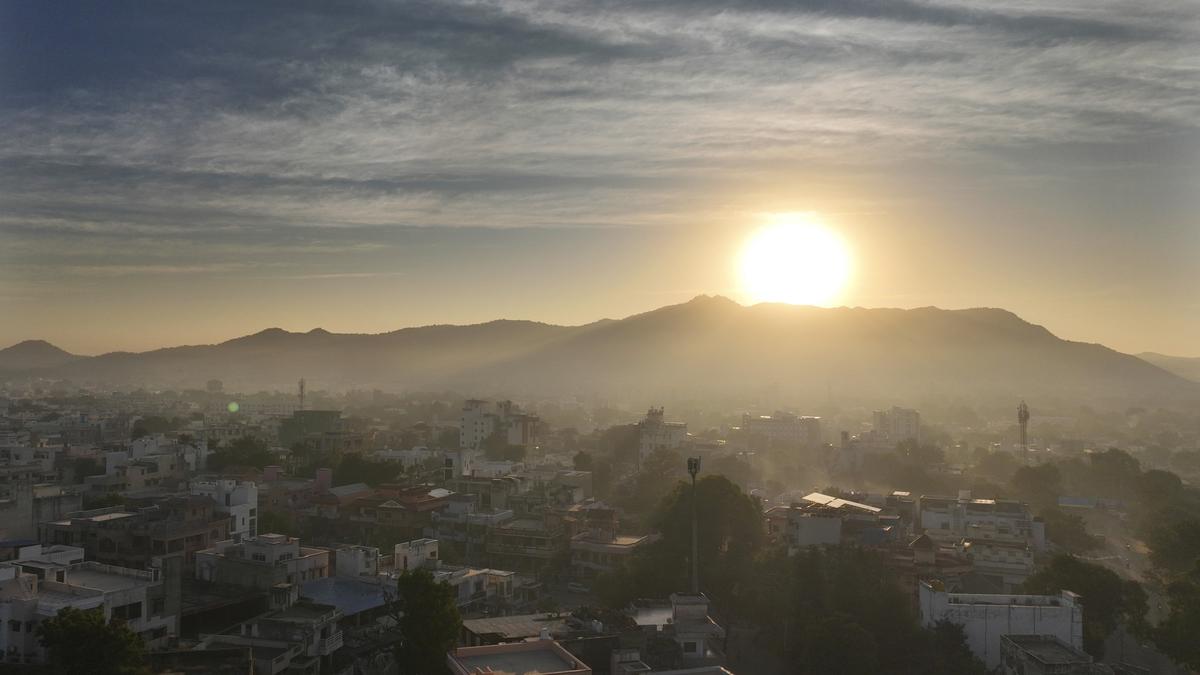A sunrise is seen against the Aravali mountain ranges in Ajmer, in Rajasthan, on December 16, 2022.
| Photo Credit: AP
The story so far: The Haryana government’s ambitious 3,858 hectare Aravali safari park project spread across Gurugram and Nuh — which was one of the poll promises of the ruling Bharatiya Janata Party last year — is envisaged to be the world’s largest safari park. However, the project has faced stiff opposition ever since it was first mooted.
What is the project?
As per the tender invited by the Haryana Tourism Department, the proposed Aravali safari park will have animal cages, guest houses, hotels, restaurants, auditoriums, an animal hospital, childrens’ parks, botanical gardens, aquariums, cable cars, a tunnel walk with exhibits, an open-air theatre and eateries. The project has now been transferred to the forest department and an expert committee has been set up to oversee it. Of the total 3,858 hectares proposed in the tender, 2,574 will be spread across 11 villages in Gurugram and the remaining 1,284 in Nuh, across its seven villages.
Why is there opposition?
The hills in the southern districts of Gurugram and Nuh are a part of Aravali, the oldest fold mountain range in the world. It runs diagonally across Rajasthan extending from Champaner in Gujarat in the southwest to near Delhi in the northeast for about 690 km. It is ecologically significant as it combats desertification by checking the spread of the Thar Desert towards eastern Rajasthan, and performs the role of an aquifer with its highly fractured and weathered quality rocks allowing water to percolate and recharge the groundwater. It is also a rich habitat to a wide spectrum of wildlife and plant species.
A group of 37 retired Indian Forest Service officers have written a letter to Prime Minister Narendra Modi seeking to scrap the project arguing that the project’s aim is to simply increase tourist footfall and not conserve the mountain range. The “primary purpose of any intervention in an eco-sensitive area should be ‘conservation and restoration’ and not destruction”, the letter said. The increased footfall, vehicular traffic and construction will disturb aquifers under the Aravali hills which are critical reserves for the water-starved districts of Gurugram and Nuh (the groundwater level in the two districts has been categorised as “over-exploited” by the Central Ground Water Board). Additionally, the location of the project falls under the category of “forest”, which is protected under the Forest Conservation Act, 1980. Besides, Haryana has very low forest cover of 3.6%, and therefore, the State needs rewilding of natural forests and not destructive safari projects, the letter said.
What are the laws protecting Aravali?
Of the approximately 80,000 hectare Aravali hill area in Haryana, a majority is protected under various laws and by orders of the Supreme Court and NGT. “The most widespread protection to the Aravalis comes from the Punjab Land Preservation Act (PLPA), 1900. The Special Sections 4 and 5 of the Act restrict the breaking of land and hence deforestation in hills for non-agricultural use….Recently around 24,000 hectares has been notified as Protected Forest under the Indian Forest Act, as a proposed offset to forest land diversion in the Nicobar islands…. Similarly, the T.N. Godavarman Thirumulpad judgment (1996) extends legal protection to forests as per dictionary meaning — which should cover the remaining Aravali areas that are not notified as forest…..the Regional Plan-2021 for the National Capital Region also offers crucial protection, designating the Aravalis and forest areas as ‘Natural Conservation Zone’ and restricting the maximum construction limit to 0.5%,” said Gurugram-based forest analyst Chetan Agarwal. Mr. Agarwal suggested that instead of a safari park, the government should declare a national park or sanctuary in the Aravalis.
Published – February 18, 2025 08:30 am IST
